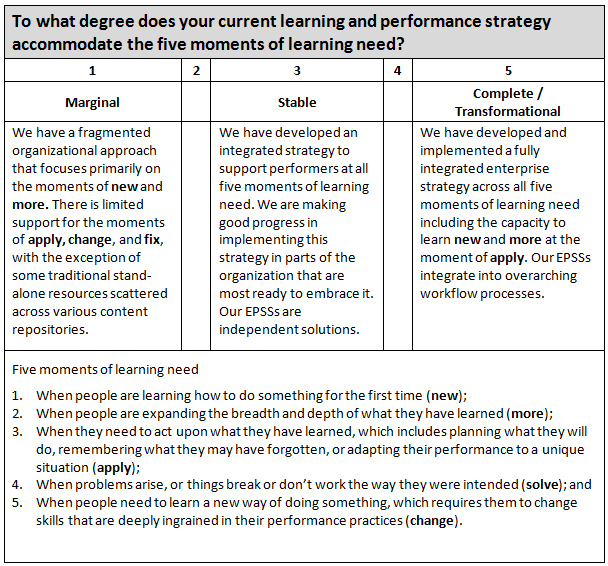What if, mere moments prior to takeoff, you discovered that the extent of your pilot’s flight training consisted of a few books he read during the previous weekend? No flight simulator. No practice. No opportunity for feedback in a safe environment. Would you feel confident that he could perform effectively at the moment of need? Probably not!
Although this scenario is a bit hyperbolic, we should remind ourselves of the importance of providing performance-based instruction to our learners that ensures we transfer and sustain real learning over time. As learning professionals, our charge is to sustain organizational competence and create a “performance zone” in our organizations.
Performance support pioneer Gloria Gery explains, “The performance zone is the metaphorical place in which things come together. It is the place where people ‘get it,’ where the right things happen, where the employee’s response exactly matches the requirements of the situation. It is the place where employees put together all the individual dance steps that they have mastered. The dance, the dancers, and the music are one.” AGILE instructional design, developed by Conrad Gottfredson, can help us get there.
Step one: Align

Figure 1: The first step in AGILE instructional design is Align
Organizations with the capacity to see change before it happens will be more successful. And to build this capacity, advises Gottfredson, today’s learning function must align with the strategy and intelligence functions. Recognizing that most organizational strategies are relatively unstable due to any number of external factors, it is even more important for the learning function to gather intelligence from the external environment. Think for a moment about your organization. What opportunities, threats, or potential crises are on the horizon? How can the learning function help respond to those changes?
But it’s not just about strategy and intelligence alignment. We must also align with our learners—the performers in our organizations. To reach the performance zone, we have to make sure our solutions accommodate the five moments of learning need, while also attending to our performers’ learning dispositions. Take a moment now to rate your current learning and performance strategy. To what degree does your current strategy accommodate all five moments of need?
 Table 1: Rating
your learning and performance strategy according to the five moments of
learning need by Gottfredson and Mosher
Table 1: Rating
your learning and performance strategy according to the five moments of
learning need by Gottfredson and Mosher
With that information in hand, you can wrap-up the align step by scoping and validating business-performance needs. Thinking about your organization and a current project, consider the following questions:
- What are the overarching business challenges and opportunities?
- What are the requisite business goals?
- What should be the business results?
Step Two: Get Set

Figure 2: The
second step in AGILE instructional design is get set
If we can all agree on the importance of preparing our learners to perform and giving them the information they need, when they need it, then we can move into the second step of AGILE instructional design—get set. Gottfredson advises beginning this step by estimating resources with your answers to a few additional questions:
- What are the performance goals?
- Who are the audiences?
- What is the estimated number of tasks?
- What existing tools and/or systems are required?
With this information in hand, you can now move to the central activities of the get set step—rapid task analysis (RTA) and critical skills analysis (CSA). The rapid task analysis (RTA), explains Gottfredson, is “a systematic approach for identifying the job tasks and related concepts for specific job roles and organizing the tasks and concepts into meaningful business processes.” Before proceeding, let’s quickly review some key terms related to conducting an RTA:
- Step: A discrete action that does not stand alone in its ability to achieve a practical outcome.
- Task: A discrete set of steps that together achieve a specific outcome.
- Process: A set of tasks that, orchestrated together, can achieve a broader outcome.
- Concept: Information that describes what something is (and sometimes, what it isn’t) and why it is important. Concepts provide the context for performance.
Most importantly, when conducting the RTA with your subject matter experts (SMEs), Gottfredson recommends the key focus should first be on identifying a random list of tasks stated in performance terms. Only after the list of tasks is generated, should you work with your SMEs to group, order, and map concepts for each task.
After completing the RTA, you can rate the impact of failure using the critical skills analysis (CSA). This rating can help you justify the allocation of learning and performance support resources for each task and concept. You can use performance-support solutions to address tasks and concepts rated on the lower end of the scale, while considering formal learning for those tasks and concepts on the upper end of the scale.
 Table 2: Rate
the impact of failure using the critical skills analysis developed by Conrad
Gottfredson
Table 2: Rate
the impact of failure using the critical skills analysis developed by Conrad
Gottfredson
You use the RTA and CSA in the creation of a learning experience and performance (LEaP) plan, which, along with the iterate & implement, leverage, and evaluate steps, will be addressed in the next and final case-study installment. Stay tuned!


